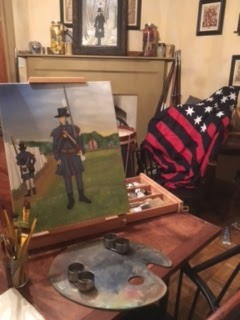Painting the forgotten past.
Adding sight to story.
In an effort to assist the mind's
eye as we peer into Brother Jonathan's world, I have recently set my
discoveries to canvas. I hope my art emboldens the interest and stirs the
imagination of fellow 1812's and all who are interested in the early history of
the United States and particularly of the region of the old Natchez Trace.
 |
| Artisan Water-Soluble paints. I really like these paints! |
 |
| A British Guard Cavalry converted to a TN Light Dragoon. One of many 25mm miniatures I've painted over the years. |
Since I was a boy I have painted countless
small metal soldiers with water-based acrylics.
Being unfamiliar with straight oils, it seemed to me a natural
progression to transfer from lead to linen using these water-based oils. So far they seem to work quite well. I have dabbled with the pure oils and for the
most part, I don’t see a significant difference.
My “studio” at present is a table in
my home. It was here on my 50th
birthday in 2016 that I decided to move on my long-held desire to paint
canvas. As it was my birthday and, at
fifty years of age I had to acknowledge my time of opportunity was becoming less
and less, I headed out for the local arts supply store. After returning home with paint and brushes
in hand, I began my first oil on canvas painting.
 |
| Uniform Tennessee Volunteer Officer ca. 1812; my first oil painting. |
 |
| Me as my own study subject. The uniform is that of an Officer of the Uniform Volunteer Company of the 27th Regiment of Maury County, Tennessee during the War of 1812. |
On this page is a sample of my
finished work as well as some studies that are still in the works. My first two paintings, Tennessee Volunteer
Officer ca. 1812 and Tennessee Volunteer Infantry ca. 1812, have been reproduced
as prints and are obtainable for purchase.
Please contact me at CLInfantry@gmail.com
for details on obtaining one of my prints or for any questions you may have
regarding my art or my blog Brother Jonathan’s Ghost.
 |
| My second work. Much different than the stark, empty winter setting of the officer painting. This painting was a challenge to my developing skills! |
 |
| Drawing the study directly to canvas. |
My second painting, Tennessee Volunteer Infantry ca. 1812,
was also produced in 2016. The setting for this painting was the New Orleans expedition of 1813. In actuality Jackson's army halted at Natchez till spring then returned up the Trace to Nashville. The scene is intended to represent the Tennesseans' camp at Washington, Mississippi just north of Natchez.
In this early exploration phase of my new found passion, I was unaware of artists’ use of graphite to transfer a drawing to canvas.
 |
| Inking in the detail before applying color. |
So, lacking that knowledge, each detail was free-styled by hand directly to the canvas. Once inked in to secure my detail, I was ready to paint.
My current works in
progress include studies of individual subjects as well as full battle
scenes. They are, in no particular
order, as follows.
 |
| Warrior of the Upper Creek nation or 'Red Stick' faction. |
A warrior of the Creek Indian Nation sports a Scalplock
adorned by three feathers. His body has
extensive tattooing with much of his upper body painted red before going into
battle. He is a conjectural drawing of Little
Warrior who led the attack that would be known as the Duck River Massacre.
 |
| Volunteer Dragoon, study 1 |
 |
| Volunteer Dragoon, study 2 |
Here is two different takes on a trooper of a Tennessee Volunteer Light Dragoon company. Established as Uniform Volunteer Companies long before the War of 1812 and the Creek War, such units were made up of the “well-to-do” families of their respective counties. Well-equipped and well organized, they would have made a quite a martial appearance on the field in comparison with other short-term units of mounted men that volunteered for service with Andrew Jackson.
 |
| Initial sketch of a battle scene set among the walled gardens of Pensacola Florida in 1814. |
On November 9th 1814, Andrew Jackson’s Army
composed of Militia from the Mississippi Territory and Tennessee, Tennessee
Volunteers, and regulars from the United States Army took the Spanish
garrisoned town of Pensacola, Florida by storm.
This initial sketch of what I hope to be a captivating painting is of
men of the 44th United States Infantry street fighting down the main
avenue after breaching the gate.
 |
| A Field Officer brings the Tennessee Volunteers into their first pitched battle at Talladega. |
Above is another work
in progress which is my most ambitious yet.
In this sketch we see the Tennessee Volunteers moving forward to
strengthen the line at the Battle of Talladega during the Creek War on November
9, 1813.
Below right is a detail of the
drummer boy of the Tennessee Line at this same battle.
 |
| A Drummer of the Tennessee Volunteers. |

No comments:
Post a Comment